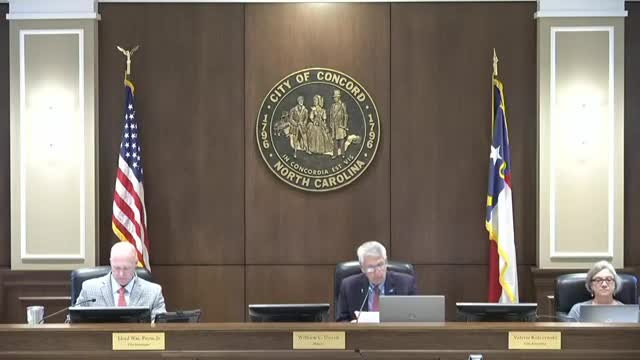Developer seeks to cut Novi project’s required affordable units from 50% to 10%, ties compliance to HUD rents
November 11, 2025 | Concord, Cabarrus County, North Carolina
This article was created by AI summarizing key points discussed. AI makes mistakes, so for full details and context, please refer to the video of the full meeting. Please report any errors so we can fix them. Report an error »

Warren Loy, senior vice president with Denholtz, told the Concord City Council at a Nov. 1 work session that the developer wants to amend the Novi Economic Development Agreement to clarify how affordable units are identified and reported and to tie the standard to HUD rents. “It does lower the amount, from 50% down to 10%, but it also clearly shows how we have to report what we have done, and it ties it explicitly to the tax grants that are part of the agreement,” Loy said.
Council members repeatedly pressed Loy and staff for specifics about unit counts and occupancy. When asked, staff and the developer said the project contains 304 units in total. Loy said current lease activity is ‘‘just over 25%’’ in terms of leases signed and estimated occupancy a couple of points behind that number.
Council members raised verification concerns. One council member asked how the city would confirm that residents in workforce units meet income thresholds; Loy said the original agreement did not require the city to verify incomes but the developer does verify that each prospective resident has gross income of at least three times the monthly rent and that “we verify that income.” Council members requested a full rent roll and supporting documentation to back the developer’s claims that an estimated 80% of offered rents meet the 80% HUD standard.
Loy and staff framed the amendment as a clarification rather than a weakening of obligations. Loy said the change was intended to reduce ambiguity and to make reporting and enforcement cleaner for future lenders and the market; he also said he believed the property is ‘‘well over the 50% contemplated in the original standard’’ based on current offered rents.
Council members pressed on stabilization and market assumptions. A council member noted stabilization is typically defined as 95% occupancy and asked whether the current leasing pace and market conditions supported reducing contractual affordable‑housing percentages. The developer said leasing has accelerated since earlier months, but council members said they wanted clearer evidence before the council votes on Thursday.
The mayor and staff said the amendment will return to council for a formal vote at the regular Thursday meeting.
What happens next: staff and the developer are expected to provide the council with a rent roll, documentation of how the developer applies HUD thresholds to unit rents, and clearer occupancy reporting before a final council vote.
Council members repeatedly pressed Loy and staff for specifics about unit counts and occupancy. When asked, staff and the developer said the project contains 304 units in total. Loy said current lease activity is ‘‘just over 25%’’ in terms of leases signed and estimated occupancy a couple of points behind that number.
Council members raised verification concerns. One council member asked how the city would confirm that residents in workforce units meet income thresholds; Loy said the original agreement did not require the city to verify incomes but the developer does verify that each prospective resident has gross income of at least three times the monthly rent and that “we verify that income.” Council members requested a full rent roll and supporting documentation to back the developer’s claims that an estimated 80% of offered rents meet the 80% HUD standard.
Loy and staff framed the amendment as a clarification rather than a weakening of obligations. Loy said the change was intended to reduce ambiguity and to make reporting and enforcement cleaner for future lenders and the market; he also said he believed the property is ‘‘well over the 50% contemplated in the original standard’’ based on current offered rents.
Council members pressed on stabilization and market assumptions. A council member noted stabilization is typically defined as 95% occupancy and asked whether the current leasing pace and market conditions supported reducing contractual affordable‑housing percentages. The developer said leasing has accelerated since earlier months, but council members said they wanted clearer evidence before the council votes on Thursday.
The mayor and staff said the amendment will return to council for a formal vote at the regular Thursday meeting.
What happens next: staff and the developer are expected to provide the council with a rent roll, documentation of how the developer applies HUD thresholds to unit rents, and clearer occupancy reporting before a final council vote.
View full meeting
This article is based on a recent meeting—watch the full video and explore the complete transcript for deeper insights into the discussion.
View full meeting
